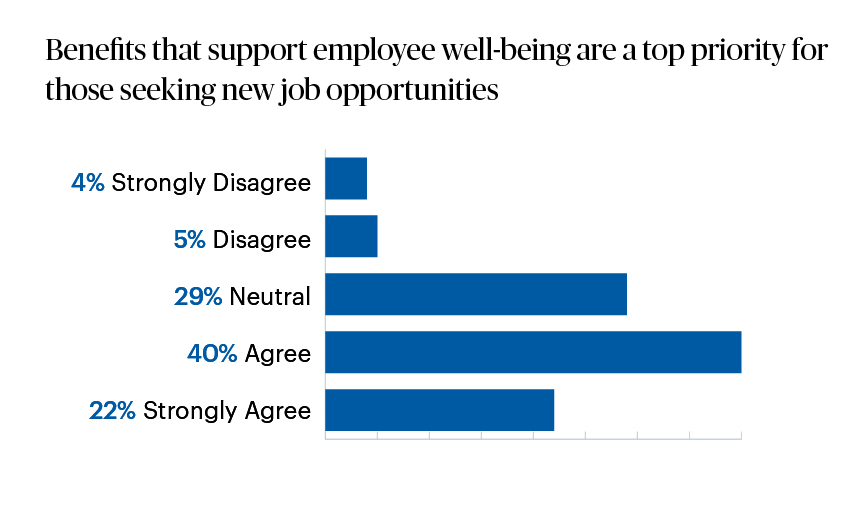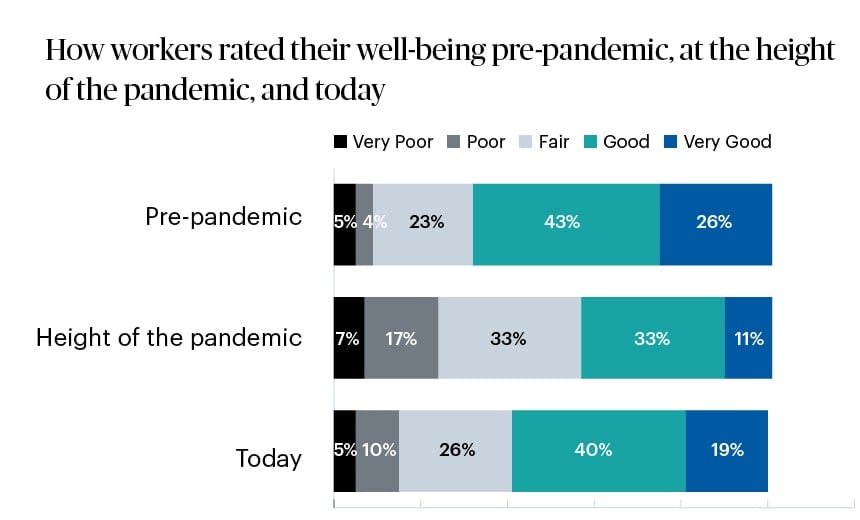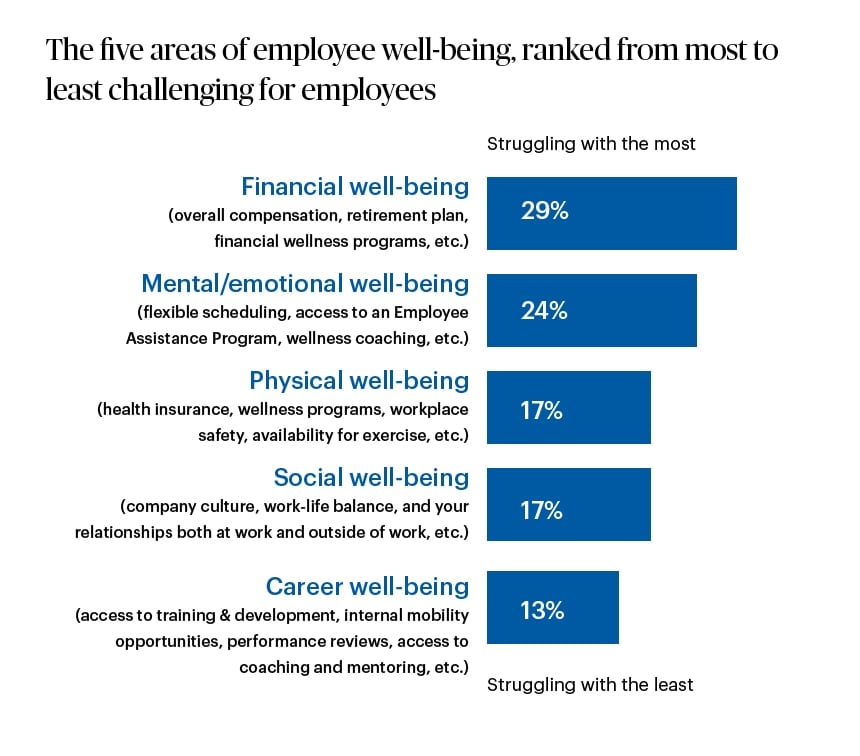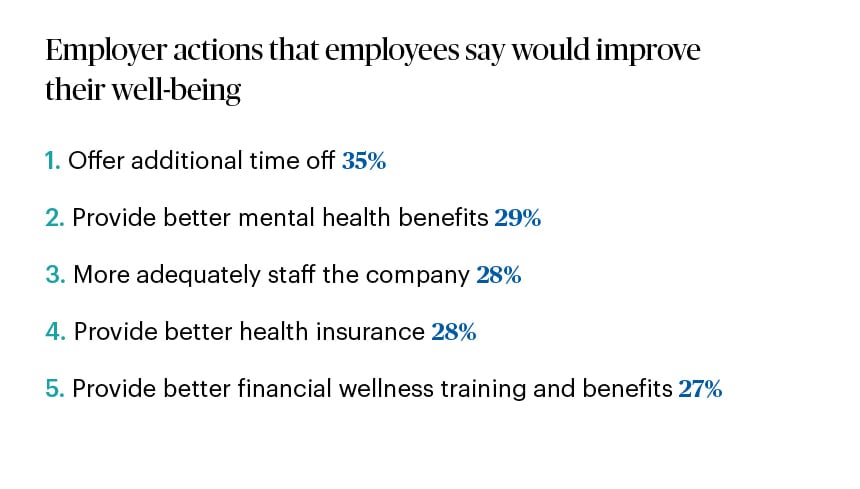Many employers understand the importance of increasing wellness in the workplace. Not only does it influence employee retention and productivity, it can ultimately affect business success. Now more than ever, meeting employee expectations for supporting their well-being is essential for employers to be able to compete for talent.
But, given the changes sparked by the COVID-19 pandemic and the Great Resignation, finding the right formula to protect and enhance employee well-being has become even more challenging.
What Defines Employee Well-being?
The term “employee well-being” may evoke deskbound employees getting up and tracking their steps, or employers offering healthier options in the breakroom vending machine. But in reality, employee well-being goes far beyond physical health: it’s about nurturing the vibrancy and growth of individuals within your organization, including their emotional, social, financial and career wellness.
To understand what workers need in order to remain healthy and thrive in the current work environment, we conducted a survey of 603 full-time employees. The participants were all living in the U.S., working at small to mid-sized businesses (20-500 employees), and aged between 18-74 years old.
Overall, how employees rated their well-being fell dramatically in 2020 at the height of the pandemic. Since then, employees say their well-being has rebounded, but it has yet to return to pre-pandemic levels, and the state of their well-being differs by generation. For example, older employees (Baby Boomers and Gen X) report their overall well-being as better than younger employees (Millennials and Gen Z), but younger employees report feeling more supported by their employers when it comes to their well-being.
Participants reported struggling with financial and emotional well-being the most, but well-being priorities differed based on generation and company size.
A few key data points from the study which this article will expand on include:
- More than 6 in 10 employees say well-being support programs/benefits will be a top priority for them when applying for their next job.
- Financial well-being is the #1 concern for employees.
- Additional time off was rated as the most important way that employers can improve employee well-being.
“Employee well-being benefits are now one of the most important criteria for employees when applying for or accepting a new job. This means that employers need to think differently about their total rewards package and consider including benefits that address the financial and mental health of their workforce.”
— Jeanne Meister, Founder of Future Workplace and Executive Vice President of Executive Networks
Key Findings: How Employee Well-being Needs Are Changing
#1 Six out of ten employees surveyed say well-being benefits are a top priority when looking for a new job.

Workplace benefits are a key deciding factor for the majority of individuals when job-hunting — this was found to be true regardless of whether employees work in-person, remotely, or a hybrid of both.
Almost half of employees feel that their current company prioritizes their overall well-being. However, significantly fewer Baby Boomers (30%) felt so compared to Gen X (48%), Millennials (50%), and Gen Z (55%).
Those in smaller companies were also more likely to feel that their overall well-being was prioritized by their employers. 52% of respondents in businesses with 20-49 employees and 50% of respondents in businesses with 50-149 employees felt it was a priority compared to just 36% of respondents whose employers have 250-500 employees.
#2 Employee well-being has improved since the height of the pandemic, but younger generations are struggling more than others.

Sixty-nine percent of our survey respondents rated their well-being as "good" or "very good" before the COVID-19 pandemic. At the height of the pandemic, however, only 43% of employees rated their well-being as being good/very good. At the time of this survey (Nov 2021), 59% of employees rank their well-being as being “good” or “very good.”
Surprisingly, despite the fact that younger generations were more likely than older generations to report that their employers prioritize their well-being, Millennials and Gen Z were significantly more likely to rate their well-being (18% and 19%, respectively) as "poor" or "very poor" compared to Gen X (12%) and Baby Boomers (8%).
#3 Financial and emotional well-being are top needs for employees

Nearly one-third of the respondents rated financial wellness as their number one worry. This included factors like overall compensation, retirement planning, and financial wellness programs. Gen X (32%) was significantly more likely to report struggling with their financial well-being than Gen Z (19%).
Twenty-four percent of employees rated mental and emotional wellness as their top struggle at work. This is because they say they lack benefits such as flexible work scheduling, or access to employee assistance, mental health, and wellness programs.
After that, physical (17%), social (17%), and career (13%) wellness were ranked as additional top struggles for them at work, respectively.
Employees in companies with 50-149 employees (19%) reported they are significantly more likely to struggle with physical health as compared to those with 150-249 employees. And Gen Z (25%) reports having significantly more trouble with physical health than Millennials (14%).
#4 Additional time off is the best way to support workplace well-being

Employees reported that additional time off is the No. 1 way for employers to support their overall well-being (35%)
Following that, mental health support (29%), adequate staffing (28%), better health insurance (28%), and financial wellness training (27%) were ranked as the next best tactics for providing the support employees need.
Additionally, Gen Z (30%) are significantly more likely to prefer childcare and/or aging parent benefits than Baby Boomers (9%), Gen X (12%), and Millennials (18%).
How to Make Workplace Well-being Work (As Reported by Employees)
- Understand that employee well-being is a key criterion for recruiting and retaining employees. Our survey found this to be true regardless of industry or work environment (remote, in-person, or hybrid). While overall employee well-being appears to be rebounding after a slump at the height of the pandemic, workers now view support for their mental, physical, and financial well-being as an important part of their benefits package. As part of their employee wellness programs, employers need to be clear as to which benefits are offered, how they are communicated, and how they can be accessed. The key attributes to implementing a mental health program for your employees include 1) openly communicating the importance of talking about mental health, 2) providing educational resources on mental health for employees to easily access, and 3) developing and deploying mental health training for managers.
- Understand the importance of financial wellness and be clear about what your business offers. Many employees surveyed said that receiving better health insurance from their employers is a key way to support their well-being, along with better financial compensation and easy access to financial wellness education and training. Our research found that employee struggles related to financial well-being differ among generations, with Gen X and Baby Boomers having the most difficulty.
- Take a regular pulse of your benefits offerings. While there might not be a one-size-fits-all benefits solution, there is an opportunity for employers to launch regular surveys and segment the data to uncover what types of well-being benefits are desired by their employees. By surveying employees regularly, employers can segment the data by generation, work environment (in-person, remote, or hybrid), and gender to identify where there might be benefit gaps and opportunities. Creating an inclusive benefits package that meets the needs of various segments of workers can provide employers with a competitive advantage in today’s marketplace when it comes to attracting and retaining top talent.
“According to the research, less than half of employees feel their company prioritizes their well-being. Employers need to understand the types of benefits that are most important and promote those benefits to avoid losing out on current and prospective talent.”
— Alison Stevens, Director of HR Services, Paychex
For more information on employee well-being and how Paychex can help businesses support the overall wellness of their workforce, tune into the PULSE podcast episode with Jake Flaitz, Director of Benefits and Wellbeing at Paychex.













